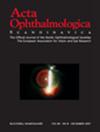本期《学报》(2023年4月)
摘要
封面插图显示视网膜总状血管瘤动静脉畸形。这是由Akter和Abousamra在这期ACTA的电子部分发表的。荷兰的Heikka和Jansonius发现,视网膜神经纤维层厚度(RNFLT)和视网膜总厚度(TRT)对青光眼的进展提供了相似的信息,除了在质量较差的扫描中,TRT更好。青光眼进展的OCT信息较少。芬兰的Pirinen等人认为玻璃体内抗vegf治疗新生血管性AMD可能会加速青光眼的进展。瑞典Dahlgren等人在一项回顾性研究中发现,局部非甾体抗炎药治疗与选择性激光小梁成形术的疗效增加无关,甚至可能降低疗效。丹麦的Ahmadi等人发现,在诊断为正常紧张性青光眼的患者中,视盘萎缩的患病率升高,这些患者的杯/盘比也较低。芬兰的Kankainen和Harju描述了常规使用丝裂霉素进行深度巩膜切除术和小梁切除术后眼内炎和眼膜炎的低发生率(0.2%)。波兰的bolek等人发现超声睫状体成形术是降低难治性青光眼患者IOP的有效且耐受性良好的方法。Lee等人在韩国发现OCT上术前乳头周围视网膜神经纤维层和神经节细胞-内丛状层厚度是预测垂体肿瘤减压后视力结果的有效生物标志物。Gärdin和瑞典的Johansson对术后使用非甾体抗炎药联合类固醇抗炎治疗进行了回顾性研究。与单独使用类固醇相比,联合用药并没有减少术后计划外就诊的需要或白内障术后视觉干扰性CME的发生率。荷兰Simons等人发现,角膜内皮膜内皮角膜移植术(DMEK)的成本效益低于超薄角膜内皮剥离自动角膜移植术(UT- DSAEK)。德国的Dail等回顾性比较了雷尼单抗、阿非利塞普和贝伐单抗玻璃体内单药治疗对naïve新生血管性年龄相关性黄斑变性患者视网膜神经节细胞层和视网膜神经纤维层的影响,发现这3种药物对视网膜神经节细胞层和视网膜神经纤维层的厚度减少相似。芬兰Lehtonen等人前瞻性地研究了非常早产儿OCT视网膜参数与运动和认知结果之间的关系。他们描述了更高的平均乳头周围视网膜神经纤维层厚度和更好的运动表现之间的联系,以及更高的神经节细胞层体积和更好的认知表现之间的联系。波兰和美国的Grzybowsky等人回顾了1752年第一次成功的白内障囊外摘除术。丹麦的Badreldin等人建议使用下一代基因测序来鉴定角膜炎中的微生物。以下文章仅发表在这一期的电子部分,可以在www.actaophthalmologica.com上访问,就像过去100年的所有Acta出版物一样。德国、奥地利、匈牙利和英国的Langenbucher等人试图开发一种利用自举技术评估理论光学公式计算人工晶状体度数时公式常数不确定性及其对预测误差影响的方法。他们通过自助证明,Haigis、Castrop和SRKT公式的非线性迭代公式常数优化技术产生了一致的结果,公式常数的不确定性低,反算平均值、中位数、平均绝对值和均方根公式预测误差的变化小。Zhang等人在中国和澳大利亚调查了外源性激素的使用与澳大利亚女性白内障手术风险之间的关系。使用激素替代疗法会增加白内障手术的风险。日本和瑞士的Motegi等人在OCT图像上描述了光感受器外段的纤维蛋白膜结构,这种结构在未经治疗的初发急性Vogt- Koyanagi- Harada病中很常见,并与疾病活动性有关。Uberos等人在西班牙得出结论,在极低出生体重的新生儿中,32周之前的红细胞输注次数和给血量是早产儿视网膜病变的重要危险因素。Chao等人认为LASIK术后角膜上皮树突状细胞的改变可能超过12个月。与P物质的关联表明角膜上皮树突状细胞在角膜神经源性炎症中的作用。中国的Yang等人发现电针在改善泪膜稳定性和干眼症症状方面优于人工泪液。 中国和美国的Li等人比较了治疗延伸(TAE)策略和固定剂量的玻璃体内注射(IVC)方案对treatment-naïve息肉样脉络膜血管病变(PCV)患者的治疗效果。两种疗法的成功率相似。以色列和阿根廷的Kredi等人描述了15%的新生血管性年龄相关性黄斑变性患者的脉络膜前裂。它与较大的视网膜和色素上皮脱离高度有关。Akter和Abousamra描述了视网膜总状血管瘤动静脉畸形。希腊的Rallis等人描述了生长受限的早产儿视网膜血管扭曲。澳大利亚的Farrall和Smith记录了眼部弥漫性大b细胞淋巴瘤的发病率和生存率。希望您在春暖花开的日子里喜欢本期《眼科学学报》。祝福你,Einar Stefánsson, Kai kaariranta。The cover illustration demonstrates retinal racemose hemangioma arteriovenous malformations. This is published by Akter and Abousamra in the electronic part of this issue of ACTA.
Heikka and Jansonius in The Netherlands found that retinal nerve fibre layer thickness (RNFLT) and total retinal thickness (TRT)gave similar information on glaucoma progression, except in poor quality scans where TRT was better. OCT becomes less informative with glaucoma progression.
Pirinen et al in Finland suggest that intravitreal anti-VEGF treatment for neovascular AMD may accelerate glaucoma progression.
Dahlgren et al in Sweden found in a retrospective study that topical NSAID treatment was not associated with an increased efficacy of selective laser trabeculoplasty and may even reduce efficacy.
Ahmadi et al in Denmark found the prevalence of optic disc drusen to be elevated in patients diagnosed with normal tension glaucoma and these patients also had a low cup/disc ratio.
Kankainen and Harju in Finland describe a low incidence (0.2%) for endophthalmitis and blebitis after deep sclerectomy and trabeculectomy with routine use of Mitomycin C.
Bolek et al in Poland found ultrasound ciliary plasty to be an effective and well-tolerated method to reduce IOP in patients with refractory glaucoma.
Lee et al in Korea found preoperative peripapillary retinal nerve fibre layer and ganglion cell- inner plexiform layer thicknesses on OCT to be effective biomarkers for predicting visual outcomes after decompression of pituitary tumours.
Gärdin and Johansson in Sweden performed a retrospective study on postoperative anti-inflammatory treatment with NSAID in combination with steroids. The combination did not reduce need for unplanned postoperative visits or incidence of visually disturbing CME after cataract surgery compared with steroids alone.
Simons et al in The Netherlands found the cost-effectiveness of Descemet Membrane Endothelial Keratoplasty (DMEK) to be inferior to Ultrathin Descemet Stripping Automated Endothelial Keratoplasty (UT- DSAEK).
Dail et al in Germany compared retrospectively the effect of monotherapy with intravitreal ranibizumab, aflibercept and bevacizumab on retinal ganglion cell layer and retinal nerve fibre layer in patients with naïve neovascular age- related macular degeneration and found similar reduction in thickness with all 3 drugs.
Lehtonen et al in Finland studied prospectively the association between retinal parameters on OCT and motor and cognitive outcomes in very preterm babies. They describe associations between higher average peripapillary retinal nerve fibre layer thickness and better motor performance as well as higher ganglion cell layer volume and better cognitive performance.
Grzybowsky et al in Poland and USA recall the first successful planned extracapsular cataract extraction in 1752.
Badreldin et al in Denmark suggest identifying microorganisms in keratitis using next- generation genetic sequencing.
The following articles are published only in the electronic part of this issue and are accessible on www.actaophthalmologica.com as are all Acta publications for the last 100 years.
Langenbucher et al in Germany, Austria, Hungary and UK tried to to develop a method for evaluation of formula constant uncertainties and the effect on the prediction error in intraocular lens power calculation with theoretical-optical formulae using bootstrap techniques. They prove with bootstrapping that nonlinear iterative formula constant optimisation techniques for the Haigis, the Castrop and the SRKT formulae yield consistent results with low uncertainties of the formula constants and low variations in the back-calculated mean, median, mean absolute and root mean squared formula prediction error.
Zhang et al in Chin and Australia investigated the association between exogenous hormone use and the risk of cataract surgery among Australian women. Use of hormone replacement therapy increased the risk of cataract surgery.
Motegi et al in Japan and Switzerland describe fibrin membranous structure in the photoreceptor outer segments on OCT images, which are common in untreated initial-onset acute Vogt- Koyanagi- Harada disease and related to disease activity.
Uberos et al in Spain conclude that in very low birth weight neonates, the number of red blood cell transfusions and their administration before 32 weeks gestational age are important risk factors for retinopathy of prematurity.
Chao et al in Australia suggest that corneal epithelial dendritic cells may remain altered more than 12 months after LASIK. An association with substance P suggests a role for corneal epithelial dendritic cells in corneal neurogenic inflammation.
Yang et al in China found electro-acupuncture to be better than artificial tears in improving tear film stability and symptoms of dry eye disease.
Li et al in China and USA compared a treat-and-extend (TAE) strategy with a fixed dosing regimen of intravitreal conbercept (IVC) for the management of treatment-naïve polypoidal choroidal vasculopathy (PCV) patients. Both regimens had similar success rates.
Kredi et al in Israel and Argentina describe a prechoroidal cleft in 15% of neovascular age- related macular degeneration patients. It is related to greater retinal and pigment epithelial detachment height.
Akter and Abousamra illustrate retinal racemose hemangioma arteriovenous malformations.
Rallis et al in Greece describe tortuosity of retinal vasculature in preterm growth-restricted neonates.
Farrall and Smith in Australia document the incidence and survival of ocular diffuse large B-cell lymphoma.
We hope you enjoy this issue of Acta Ophthalmologica in wonderful spring weather.
Best wishes,
Einar Stefánsson, Kai Kaarniranta.

 求助内容:
求助内容: 应助结果提醒方式:
应助结果提醒方式:


